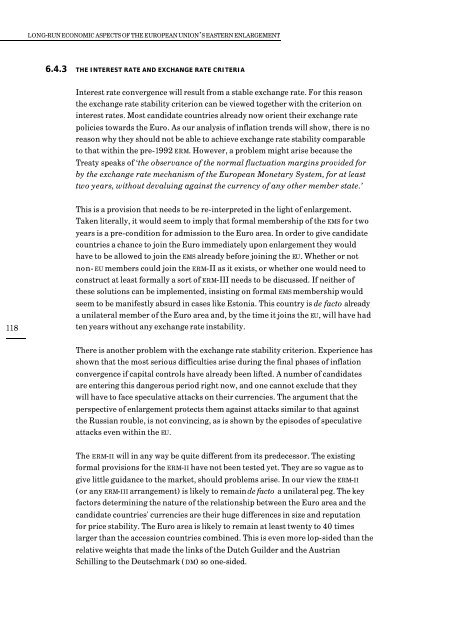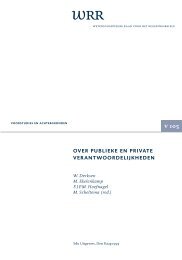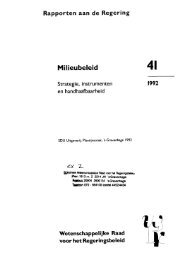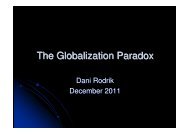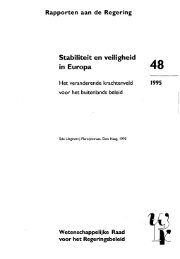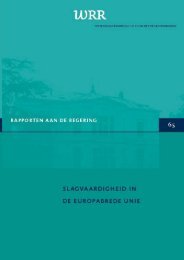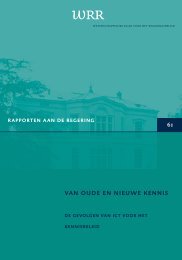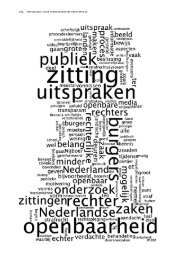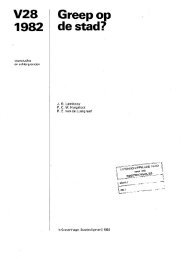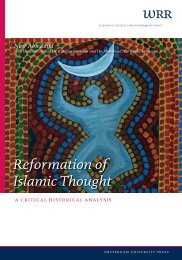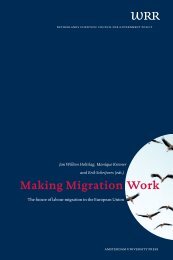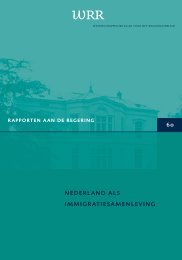w 109 long-run economic aspects of the european union's eastern ...
w 109 long-run economic aspects of the european union's eastern ...
w 109 long-run economic aspects of the european union's eastern ...
You also want an ePaper? Increase the reach of your titles
YUMPU automatically turns print PDFs into web optimized ePapers that Google loves.
LONG-RUN ECONOMIC ASPECTS OF THE EUROPEAN UNION’S EASTERN ENLARGEMENT6.4.3 THE INTEREST RATE AND EXCHANGE RATE CRITERIAInterest rate convergence will result from a stable exchange rate. For this reason<strong>the</strong> exchange rate stability criterion can be viewed toge<strong>the</strong>r with <strong>the</strong> criterion oninterest rates. Most candidate countries already now orient <strong>the</strong>ir exchange ratepolicies towards <strong>the</strong> Euro. As our analysis <strong>of</strong> inflation trends will show, <strong>the</strong>re is noreason why <strong>the</strong>y should not be able to achieve exchange rate stability comparableto that within <strong>the</strong> pre-1992 ERM. However, a problem might arise because <strong>the</strong>Treaty speaks <strong>of</strong> ‘<strong>the</strong> observance <strong>of</strong> <strong>the</strong> normal fluctuation margins provided forby <strong>the</strong> exchange rate mechanism <strong>of</strong> <strong>the</strong> European Monetary System, for at leasttwo years, without devaluing against <strong>the</strong> currency <strong>of</strong> any o<strong>the</strong>r member state.’118This is a provision that needs to be re-interpreted in <strong>the</strong> light <strong>of</strong> enlargement.Taken literally, it would seem to imply that formal membership <strong>of</strong> <strong>the</strong> EMS for twoyears is a pre-condition for admission to <strong>the</strong> Euro area. In order to give candidatecountries a chance to join <strong>the</strong> Euro immediately upon enlargement <strong>the</strong>y wouldhave to be allowed to join <strong>the</strong> EMS already before joining <strong>the</strong> EU. Whe<strong>the</strong>r or notnon- EU members could join <strong>the</strong> ERM-II as it exists, or whe<strong>the</strong>r one would need toconstruct at least formally a sort <strong>of</strong> ERM-III needs to be discussed. If nei<strong>the</strong>r <strong>of</strong><strong>the</strong>se solutions can be implemented, insisting on formal EMS membership wouldseem to be manifestly absurd in cases like Estonia. This country is de facto alreadya unilateral member <strong>of</strong> <strong>the</strong> Euro area and, by <strong>the</strong> time it joins <strong>the</strong> EU, will have hadten years without any exchange rate instability.There is ano<strong>the</strong>r problem with <strong>the</strong> exchange rate stability criterion. Experience hasshown that <strong>the</strong> most serious difficulties arise during <strong>the</strong> final phases <strong>of</strong> inflationconvergence if capital controls have already been lifted. A number <strong>of</strong> candidatesare entering this dangerous period right now, and one cannot exclude that <strong>the</strong>ywill have to face speculative attacks on <strong>the</strong>ir currencies. The argument that <strong>the</strong>perspective <strong>of</strong> enlargement protects <strong>the</strong>m against attacks similar to that against<strong>the</strong> Russian rouble, is not convincing, as is shown by <strong>the</strong> episodes <strong>of</strong> speculativeattacks even within <strong>the</strong> EU.The ERM-II will in any way be quite different from its predecessor. The existingformal provisions for <strong>the</strong> ERM-II have not been tested yet. They are so vague as togive little guidance to <strong>the</strong> market, should problems arise. In our view <strong>the</strong> ERM-II(or any ERM-III arrangement) is likely to remain de facto a unilateral peg. The keyfactors determining <strong>the</strong> nature <strong>of</strong> <strong>the</strong> relationship between <strong>the</strong> Euro area and <strong>the</strong>candidate countries' currencies are <strong>the</strong>ir huge differences in size and reputationfor price stability. The Euro area is likely to remain at least twenty to 40 timeslarger than <strong>the</strong> accession countries combined. This is even more lop-sided than <strong>the</strong>relative weights that made <strong>the</strong> links <strong>of</strong> <strong>the</strong> Dutch Guilder and <strong>the</strong> AustrianSchilling to <strong>the</strong> Deutschmark (DM) so one-sided.


